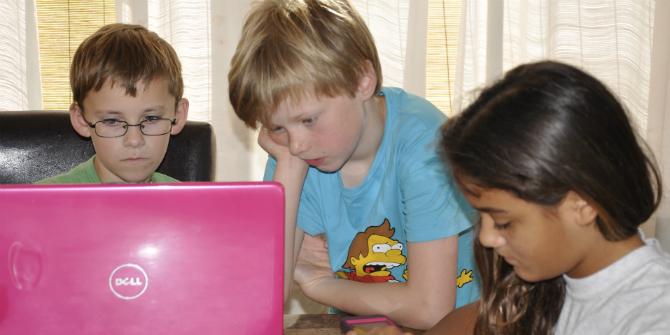 There’s no doubt that the pandemic has altered our relationship with media and technology over the last year, especially for young people whose education, entertainment, and engagement with friends and family rapidly moved online, making their lives digital by default. Existing concerns about screen time and digital parenting were pushed to the background as the pandemic fuelled debates on online access, digital divides, literacies and wellbeing. For www.parenting.digital, Devina Sarwatay discusses how digital inequalities in India affect children’s media literacy, digital citizenship and can impact young people’s futures.
There’s no doubt that the pandemic has altered our relationship with media and technology over the last year, especially for young people whose education, entertainment, and engagement with friends and family rapidly moved online, making their lives digital by default. Existing concerns about screen time and digital parenting were pushed to the background as the pandemic fuelled debates on online access, digital divides, literacies and wellbeing. For www.parenting.digital, Devina Sarwatay discusses how digital inequalities in India affect children’s media literacy, digital citizenship and can impact young people’s futures.
Children’s rights apply in the digital world and it is important not only to recognise this but also to work towards supporting children and their parents to become digitally resilient. However, we are still discovering how local contexts and nuances of experience might alter conceptions of media literacy, digital citizenship and social connectedness in the Global South. The few studies in contexts outside the Global North, and India in particular, indicate that young people may interact with technology in various culturally specific ways, highlighting the need for a culture-centred approach to media literacy and digital citizenship for youth.
Stark digital divides
Many technological realities co-exist in India, characterised by stark digital divides. Within one metropolitan city, you will find affluent households that have multiple devices per person with the fastest fibre-optic unlimited internet connectivity providing opportunities for study, work, and entertainment. In close proximity, other households share mobile devices between multiple family members, used sparingly only for important tasks due to limited mobile data and internet services. Such stark digital divides occur in many countries in the Global South and for certain communities in the Global North as well – for example, millions in the United States have no or poor access to the internet.
Digital inequalities and their various corresponding responses exist across the globe. This is where we begin to feel the need to localise approaches and reactions. Access in India has been increasing due to lowering costs of devices and connectivity, giving rise to technopanics regarding screen time and negative effects on children’s wellbeing and school performance. The scholarship is still catching up and, more often than not, concepts and models from the Global North influence research with little sensitivity to local nuances and contexts.
Media literacy and digital citizenship – the missing link
While the literature in the Global North identifies political participation and activism as key components of digital citizenship and ties media literacy and education to it, there is a need for more research on this from the Global South. In fact, Indian scholars and policy-makers rarely make the connection between media literacy and digital citizenship, especially in relation to young people. Media education tends to focus on the skills needed for the production of content rather than on literacy and critical thinking in an environment that seems to demand these skills for effective participation in a digital and social media world. Digital citizenship, on the other hand, is mainly focused on e-safety and privacy aiming to protect young people from online risks.
This approach seems dated in a COVID-19 digital by default world. To do that, we need to go back to stakeholders, including young people and their parents, with a culture-centred approach asking them about how they experience and conceptualise media literacy and digital citizenship.
Setting the new agenda
To address this gap and move the conversation further, we conducted a study that takes an ecosystem-based approach to digital citizenship and online connectedness in India. We conducted interviews with professionals from Ahmedabad working with young people and their parents in both informal and formal learning contexts asking them to discuss the problems they face and identify possible solutions.
A key issue that the stakeholders identified is that opportunities and risks always go hand in hand and the level of digital literacy can help capitalise on opportunities while minimising risks. The lack of child-centred design of the online environment was another concern that parents and educators had to be mindful of when teaching children about online participation. There were parental anxieties around children’s technology use, as well as some hypocrisy where parents indulged in the same online behaviour they asked their children to refrain from due to concerns for their privacy, safety, and wellbeing. Positive parental involvement which brings a balance to young people’s digital lives is among the mitigating approaches suggested by the stakeholders we spoke to.
These concerns and gaps are important in a context where digital participation is becoming increasingly important for learning. In India, for example, you need to create an online profile to register for an entrance exam for higher education. This now applies to younger children as well when their exams are conducted remotely. With education gone online, young people are already experiencing aspects of digital citizenship, as well as the exclusions faced by media-deprived children. We are also seeing a shift in employment trends with work-from-home being introduced in several job sectors with the possibility of becoming a permanent feature in near future. This also means that our education needs to be geared towards imparting these skills to young people so that they are ready to face the future. It also suggests that measures need to be taken to tackle existing inequalities to ensure that all children are equipped to be fully participating digital citizens.
With the inclusion of “General comment no. 25 (2021) on children’s rights in relation to the digital environment” in the Convention on the Rights of the Child, states must do more to encourage a culture-centred approach to research and practice foregrounding children’s and other stakeholders’ voices in their advocacy and efforts towards a safe, engaging, creative, equitable space in a digital world. This would ideally translate into considering the experiences of children and adult caregivers from India related to media literacy and digital citizenship along with the gaps that advocacy and governance might need to fill through education and regulation.
First published at www.parenting.digital, this post represents the views of the authors and not the position of the Parenting for a Digital Future blog, nor of the London School of Economics and Political Science.
You are free to republish the text of this article under Creative Commons licence crediting www.parenting.digital and the author of the piece. Please note that images are not included in this blanket licence.





